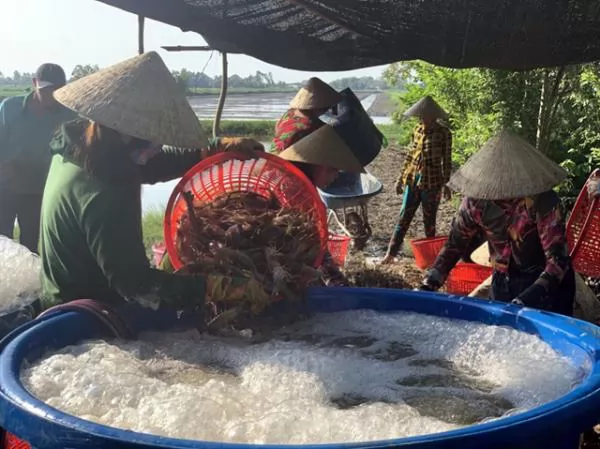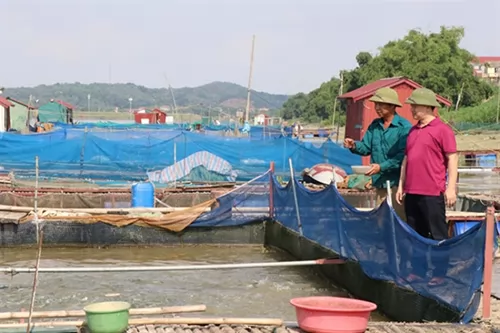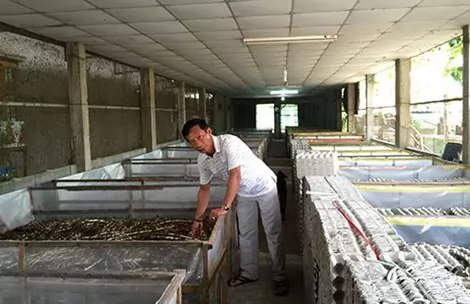Kiên Giang expands lucrative shrimp-breeding models

Farmers harvest giant river prawn in Kiên Giang Province's U Minh Thượng District on the third day of Tết (Lunar New Year). - VNA/VNS Photo Lê Sen
KIÊN GIANG – The Cửu Long (Mekong) Delta province of Kiên Giang plans to expand its brackish-water shrimp farming areas this year in an aim to increase farmers' incomes and adjust to soil, water and climatic conditions.
Quảng Trọng Thao, deputy director of the provincial Department of Agriculture and Rural Development, said that intensive industrial shrimp breeding with advanced techniques would be done in areas that have sufficient infrastructure and investment capacity, primarily in the Long Xuyên Quadrangle.
The province will also review and turn unproductive rice fields into rice – shrimp farming fields that rotate the cultivation of shrimp and rice on the same fields, he added.
The province is encouraging farmers to breed shrimp using advanced two-stage and three-stage industrial farming models, and apply Vietnamese good agricultural practice (VietGAP) standards and other international farming standards to meet export requirements.
The province is developing rice – shrimp farming areas in the districts An Biên, An Minh, Vĩnh Thuận, U Minh Thượng, Gò Quao, Hòn Đất, Kiên Lương and Giang Thành.
Kiên Giang, which is the country’s largest rice producing province, has turned thousands of hectares of unproductive rice fields in coastal areas into rice-and-shrimp rotation models in recent years.
With a coastline of more than 200 kilometres, the province has advantages to develop rice – shrimp farming models in coastal areas.
Hòn Đất District alone has conditions to develop its rice – shrimp farming area to 20,000ha. The district plans to expand the area to 16,000ha by 2030.
Under the rice - shrimp farming model, farmers rotate growing rice in the rainy season and breeding shrimp in the dry season in the same fields, or intercrop breeding shrimp in ditches around rice fields and growing rice at the same time.
The rice - shrimp farming model offers farmers an average profit of VNĐ70 – 100 million (US$3,000 – 4,400) per hectare a year, two to three times higher than only rice cultivation, according to farmers.
Farmer Huỳnh Văn Bạc has intercropped cultivating mùa rice and giant river prawn on 3ha in Châu Thành District’s Vĩnh Hòa Phú Commune since 2017.
He has earned an average profit of more than VNĐ160 million ($7,000) a crop.
Mùa rice is planted only in the rainy season and lasts about six months each crop.
“The cultivation of mùa rice helps farmers reduce production costs and get high prices. I also earn additional income from harvesting giant river prawn,” Bạc said.
He said that farmers need help from local agencies to access soft loans and advanced farming techniques.
Since early this year, farmers have received high prices for shrimp varieties because of high export demand.
The price of white-legged shrimp, for instance, increased to VNĐ150,000 – 198,000 ($6.5 – 8.6) a kilogramme early this year, up VNĐ10,000 – 15,000 against the end of last year.
Farmers who breed giant river prawn had a bumper harvest of shrimp before and after Tết (Lunar New Year). Traders are buying giant river prawn at a high price of VNĐ130,000 – 180,000 ($5.7 – 7.8) a kilogramme, depending on their size.
The brackish-water shrimp farming area will be expanded to 136,000 ha with an annual output of 98,000 tonnes this year, according to the province's Department of Agriculture and Rural Development.
Of the figure, industrial and semi-industrial farming models will cover 4,000ha, shrimp – rice farming 104,500ha, and advanced extensive farming 27,500ha.
Last year, the province bred 134,235ha of brackish-water shrimp with an annual output of 92,490 tonnes. – VNS
Maybe you are interested

Oxygen depletion causes fish deaths in Bắc Ninh
BẮC NINH — Oxygen depletion is allegedly responsible for killing tonnes of fish in Bắc Ninh Province’s Cầu River last week.

Breeding insects for export, a new industry for VN
VietNamNet Bridge - The most difficult procedures in insect export is asking for the certificate of quality, size and the certificate of origin for insects.

Taxing farm animals\' farts and burps? Denmark gives it a try
Denmark, known for its inventive restaurants and elegant design studios, is about to become known for something more basic: the world's first belch and manure tax.





